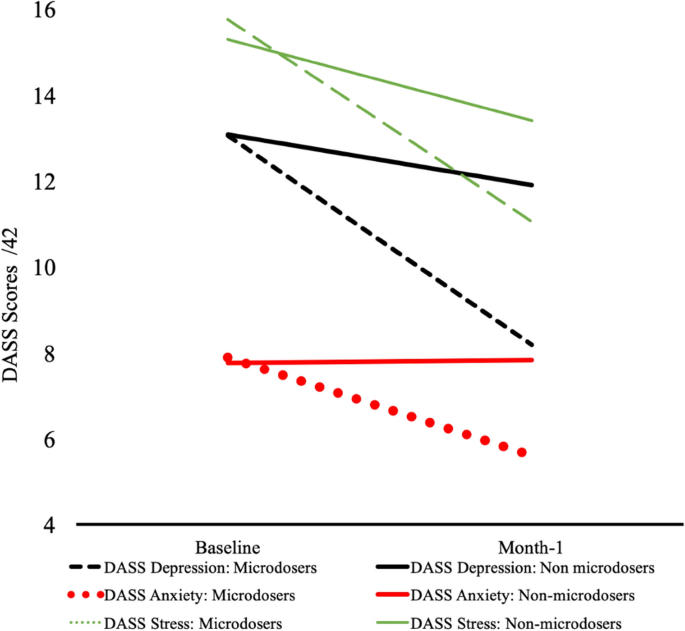Microdosers were more likely than non-microdosers to be older (x2 (2, N = 1133) = 22.13, p < 0.01), of White ethnicity (x2 (1, N = 1133) = 4.62, p = 0.03) and to report full-time employment (x2 (3, N = 1122) = 11.83, p < 0.01); groups were equivalent in all other demographic domains (all x2’s < 6.03, all p’s 0.05; see Table 1). Comparisons among microdosers of dosage and past-month microdose days found no differences across Age (days: x2 (2, N = 953) = 3.37, p = 0.19; dose: x2 (2, N = 953) = 3.31, p = 0.19) and Mental Health Concerns (days: x2 (2, N = 931) = 0.71, p = 0.70; dose: x2 (2, N = 931) = 0.21, p = 0.90).
Preliminary analyses identified expected differences according to Age; the under 55 group demonstrated superior performance to the 55 + group on all cognitive tasks; for Tap Test (Mean = 70.48 (33.18) versus 52.60 (29.99); t (1, 863) = 5.05, p < 0.01); for PASAT (Mean = 33.67(14.21) versus 30.37 (12.92) t (1, 772) = 2.08, p < 0.05) and Spatial Span (Mean = 236.25 (51.02) versus 176.88 (58.80); t (1, 943) = 11.00, p < 0.01). Baseline differences by Age were identified for negative mood (mean = 46.89 (16.13) versus 40.64 (16.06); t (1, 1048) = 3.96, p < 0.01) but not positive mood (mean = 55% (16) versus 55.03% (15.01); t (1, 1048) = − 0.018, p = 0.99). As expected, participants who reported Mental Health Concerns evinced higher scores on all three DASS subscales: Depression (mean = 10.44 (9.72) versus 18.92 (12); t (1, 1010) = − 11.81, p < 0.01); Anxiety (mean = 6.38 (6.36) versus 11.38 (8.74); t (1, 1010) = 10.09, p < 0.01) and Stress (mean = 13.84 (9.1) versus 20.04 (9.8); t (1, 1010) = 9.61, p < 0.01). Gender analysis revealed no main effect of gender across time in any of the DASS domains (All F < 1.6, p 0.20).
Depression, anxiety, stress
Comparisons of microdosers to non-microdosers in change from baseline to month-1 (Microdose*time) indicated greater improvements among microdosers across the DASS domains of Depression (F (1, 1019) = 17.91, b = 0.12, p < 0.01), Anxiety (F (1, 1017) = 18.33, b = 0.08, p < 0.01), and Stress (F (1, 1016) = 15.60, b = 0.08, p < 0.01) (Fig. 1; Table 2). These effects remained consistent following the removal of 124, 82, and 75 outliers within Depression, Anxiety, and Stress domains respectively for scores exceeding 2 standard deviations from the mean (all Microdose*time F 7.99 p < 0.01), and in parallel analyses restricted to the 594 participants who did not report microdosing prior to baseline (all Microdose*time F 4.17, p < 0.05). We identified a Microdose*Gender*Time interaction such that the effect of microdosing over time was found to be moderated by gender in DASS depression. Specifically, microdose-related reductions in depression were stronger among females than among males (F (1, 1016) = 6.61, b = 0.17, p = 0.01). No Microdose* Gender*Time interaction was identified for DASS anxiety (F (1, 1024) = 1.14, b = 0.46, p = 0.29) or DASS stress (F (1, 1023) = 0.90, b = 0.05, p = 0.34).

Microdosing and mental health. “Baseline” values reflect the mean participant responses collected 0–7 days from study initiation. “Month-1” values reflect the mean participant responses collected 22–35 days following study initiation.
The interactions between Mental Health Concerns and Microdose groups were not significant for any of the domains (all Microdose*Mental Health Concerns*Time…
Read more:Psilocybin microdosers demonstrate greater observed improvements in mood and mental








 Bitcoin
Bitcoin  Ethereum
Ethereum  XRP
XRP  Tether
Tether  Solana
Solana  Dogecoin
Dogecoin  USDC
USDC  Cardano
Cardano  Lido Staked Ether
Lido Staked Ether  TRON
TRON  Avalanche
Avalanche  Sui
Sui  Wrapped stETH
Wrapped stETH  Chainlink
Chainlink  Toncoin
Toncoin  Shiba Inu
Shiba Inu  Stellar
Stellar  Wrapped Bitcoin
Wrapped Bitcoin  Hedera
Hedera  Polkadot
Polkadot  WETH
WETH  Bitcoin Cash
Bitcoin Cash  Uniswap
Uniswap  Pepe
Pepe  LEO Token
LEO Token  Hyperliquid
Hyperliquid  Litecoin
Litecoin  Wrapped eETH
Wrapped eETH  NEAR Protocol
NEAR Protocol  Internet Computer
Internet Computer  Ethena USDe
Ethena USDe  USDS
USDS  Aptos
Aptos  Aave
Aave  Mantle
Mantle  Bittensor
Bittensor  POL (ex-MATIC)
POL (ex-MATIC)  Virtuals Protocol
Virtuals Protocol  Cronos
Cronos  Ethereum Classic
Ethereum Classic  Render
Render  Artificial Superintelligence Alliance
Artificial Superintelligence Alliance  MANTRA
MANTRA  Tokenize Xchange
Tokenize Xchange  Arbitrum
Arbitrum  Ethena
Ethena  WhiteBIT Coin
WhiteBIT Coin